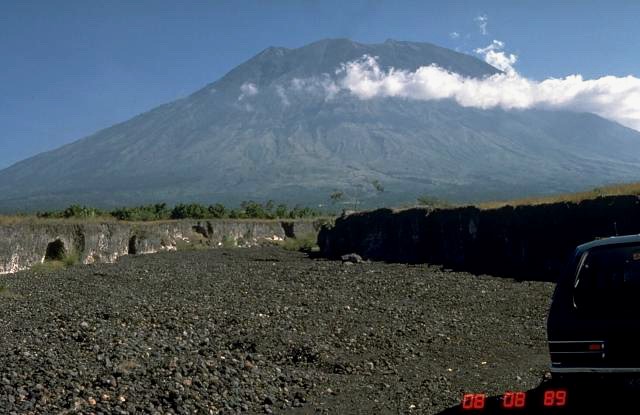

Mount Agung and its potential global impacts
Since mid-November 2017, Mount Agung on the Indonesian Island of Bali has been emitting steam and ash. Lava is visible in the crater, and rivers of mud have been flowing down its sides. However, Agung is capable of a much more explosive eruption, which would have a much greater impact locally and globally. The more explosive the eruption, the higher the volcanic ash, sulphur gases and other debris are pushed into the atmosphere. Agung last erupted in 1963, having been dormant for over a century. On that occasion, more than 1,000 people were killed - most of them caught in pyroclastic flows - hot gas and rocks moving away from the volcano at speeds of up to 200 m/s - or by a flowing muddy river of water and volcanic matter known as a lahar.
In 1963, material reached as high as 26 km above sea level – far into the stratosphere. As we’ll see below, if volcanic material from the Tropics gets into the stratosphere, it can impact global climate for several years.
In the last 100 years, the years immediately after the eruptions of El Chichon (1982), Agung (1963), and Pinatubo (1991) stand out as being abnormally cold. Estimates suggest that Agung’s eruption cooled global climate for about a year for a few tenths of a degree. It doesn’t sound much, but remember, this is an average. Some places will cool more than others, and some periods of time will be colder than others. For example, the combined eruptions of Tambora, Indonesia (1815), La Soufriere, Saint Vincent (1812) and Mayon in the Philippines (1814) only reduced global average temperatures by about half a degree but were enough to cause the ‘year with no summer’ and bring death and disease to hundreds of thousands.
Massive explosive volcanic eruptions push sulphur gases up into the stratosphere, where they condense into an aerosol (small particles) which are highly reflective - reflecting the Sun’s light back into space before it reaches the ground to warm it.
Why do volcanic eruptions have to be explosive to have a lasting impact on the weather? In the troposphere (the lower 10km or so of the atmosphere), the temperature mainly falls with height – at somewhere between 5-10°C/ km. Air rising through the troposphere cools (at the adiabatic lapse rate) and, as it cools, can be either warmer or colder than the air around it. If the rising air is colder than the air around it, it sinks back down again – a stable situation. If the rising air is warmer than the air around it, it carries on rising, and we see convective clouds – for example, cumulus or cumulonimbus. This is an unstable situation. Air in the troposphere can therefore move up and down relatively easily and is well mixed.
On the other hand, in the stratosphere, the temperature always increases with height. This is because the ozone in the stratosphere absorbs the ultraviolet part of the Sun’s radiation and re-emits the energy as heat, warming the stratosphere. This means that any air trying to rise from the troposphere, cooling as it rises, will always be colder than the surrounding air and sink back to the troposphere. As a result, it is very hard for air to mix vertically from the troposphere to the stratosphere or within the stratosphere. This is why cumulonimbus or thunder clouds can have a characteristic anvil-shaped top – the air rising in an unstable troposphere hits the bottom of the stratosphere and cannot rise into it, so it spreads out sideways.
Only very explosive volcanoes can blast material into the stratosphere.
If volcanic material remains in the troposphere, it is removed relatively rapidly – e.g. by gravity and rain. If it can get up into the stratosphere, it has an impact for much longer. Sulphur dioxide oxidizes relatively slowly into sulphuric acid, which reflects the Sun’s light, cooling the Earth.
Material in the stratosphere gets caught up in the Brewer-Dobson circulation – the large-scale circulation of the stratosphere, analogous to the Hadley circulation of the troposphere. The Brewer-Dobson circulation is driven by powerful convection in the tropical troposphere, which can sometimes push tropospheric air up into the stratosphere.
Major eruptions in the tropics have a more significant effect on the climate because the material from the explosion can be carried into both hemispheres by the Brewer-Dobson circulation. Material from major eruptions in the mid-to-high latitudes of each hemisphere tends to remain poleward of the eruption latitude. Therefore, significant Icelandic eruptions only influence the Northern Hemisphere's higher latitudes.
Cooling is most pronounced over land because land heats up and cools down faster than large bodies of water. As a result, large explosive tropical volcanoes have a smaller but longer-lasting effect on the climate of the Southern Hemisphere because there is less land.
The effects in the Northern Hemisphere are greatest in the summer season because, then, the Sun’s radiation levels are at their maximum, so increasing the atmosphere's reflectivity will have the biggest effect. In the winter, when light levels are low anyway, it doesn’t really matter if some of that light is blocked out. However, in the summer, when we and the vegetation we rely on for food expect light, we notice it far more if something stops that light from reaching the ground.
The crucial factor in determining the climate impact is not necessarily the magnitude of the eruption but is thought to be the quantity of sulphur dioxide (SO₂) injected into the stratosphere. Ash falls or is washed out of the atmosphere far faster than SO₂.
Further links
MetLink teaching resource on Climate Change - the Last 500 years
Carbon Brief Analysis: How could the Agung volcano in Bali affect global temperatures?




